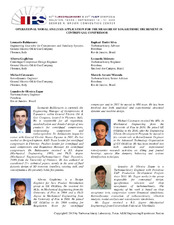| dc.contributor.other | Turbomachinery Symposium (44th : 2015) | |
| dc.creator | Guglielmo, Alberto | |
| dc.creator | Baldassarre, Leonardo | |
| dc.creator | Catanzaro, Michael | |
| dc.creator | Zague, Leandro de Oliveira | |
| dc.creator | Ishimoto, Leonardo | |
| dc.creator | Miranda, Marcelo Accorsi | |
| dc.creator | Silva, Raphael Timbo | |
| dc.date.accessioned | 2017-09-09T14:06:22Z | |
| dc.date.available | 2017-09-09T14:06:22Z | |
| dc.date.issued | 2015 | |
| dc.identifier.uri | https://hdl.handle.net/1969.1/162186 | |
| dc.description | Lecture | en |
| dc.description.abstract | The results of a stability test on a centrifugal compressor during the full load test of the entire compression train are presented. A Magnetic Exciter was installed at the shaft end in order to excite the first lateral mode of the rotor at running conditions, the frequency and logarithmic decrement of the first mode was identified by analyzing the Frequency Response Functions with classic techniques (D.J. Ewins, 1984). A new method for turbomachinery applications based on Operational Modal Analysis (OMA) is presented for the identification of modal parameters. Thanks to the natural excitation exerted by the gas flow on the rotor it is possible to avoid the use of any external device to perform the identification. The vibration signals have been recorded over proper measurement time windows with the compressor at steady state. The Stochastic Subspace Identification (a statespace algorithm in time domain) has been used to post-process the data. Modal parameters of the first lateral mode (natural frequency, damping ratio and mode shape) have been identified. A comparison between the two identification techniques on the identified frequency and logarithmic decrement of the first lateral mode was performed showing the potential of the OMA methodology. In addition four numerical cases with different stability levels were studied to confirm the reliability of the methodology for rotating machinery. A transient analysis was performed by applying a random excitation at mid-span and vibration responses have been evaluated at bearing locations. For each case the modal parameters were identified using OMA and compared with the exact theoretical values. | en |
| dc.format.medium | Electronic | en |
| dc.format.mimetype | application/pdf | |
| dc.language.iso | en | |
| dc.publisher | Turbomachinery Laboratories, Texas A&M Engineering Experiment Station | |
| dc.relation.ispartof | Proceedings of the 44th Turbomachinery Symposium | en |
| dc.subject.lcsh | Turbomachines | en |
| dc.title | Operational modal analysis application for the measure of logarithm decrement in centrifugal compressor | en |
| dc.type.genre | Presentation | en |
| dc.type.material | Text | en |
| dc.format.digitalOrigin | born digital | en |
| dc.identifier.doi | https://doi.org/10.21423/R1WK87 | |


